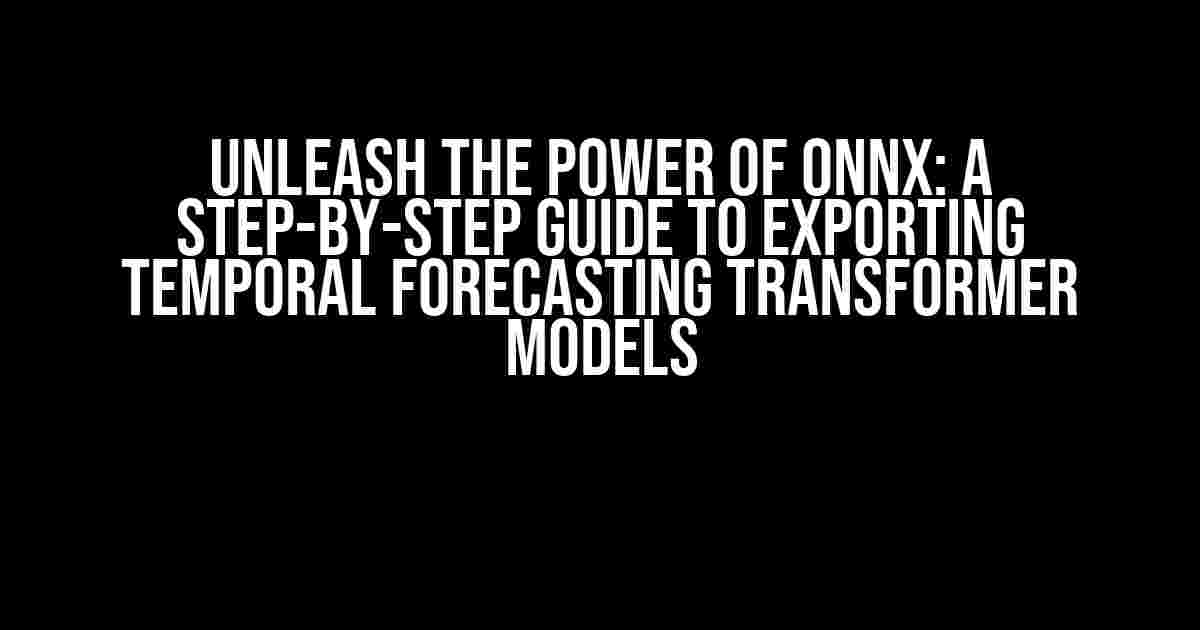Are you tired of being limited by the constraints of your deep learning framework? Do you want to deploy your temporal forecasting transformer model to a wider range of environments, from cloud to edge devices? Look no further! In this comprehensive guide, we’ll walk you through the process of exporting your temporal forecasting transformer model as an ONNX model, opening up a world of possibilities for model deployment and optimization.
What is ONNX, and Why Should I Care?
ONNX (Open Neural Network Exchange) is an open format used to represent deep learning models in a way that’s platform-agnostic, meaning it can be easily transferred between different frameworks, hardware, and environments. By exporting your model as an ONNX model, you can:
- Deploy your model to various platforms, including cloud, edge, and mobile devices
- Optimize your model for faster inference and reduced latency
- Use your model with other frameworks and tools, such as TensorFlow, PyTorch, or OpenCV
- Share your model with others, without worrying about compatibility issues
Prerequisites: What You Need to Get Started
Before we dive into the export process, make sure you have the following:
- A trained temporal forecasting transformer model (we’ll use PyTorch as an example)
- PyTorch installed on your system (version 1.9 or later)
- The ONNX library installed (pip install onnx)
- A basic understanding of Python and deep learning concepts
Step 1: Prepare Your Model for Export
Before exporting your model, you need to ensure it’s in a suitable format for ONNX conversion. This involves:
-
torch.jit.scriptyour model:import torch model = ... # your trained temporal forecasting transformer model script_model = torch.jit.script(model)This step compiles your PyTorch model into a TorchScript module, which can be exported to ONNX.
-
Move your model to the CPU:
script_model.to('cpu')This ensures that the model is not tied to a specific GPU, making it more portable.
Step 2: Export Your Model as an ONNX File
Now that your model is prepared, you can export it as an ONNX file using the torch.onnx module:
import torch.onnx
torch.onnx.export(
script_model, # your TorchScript model
(), # no inputs (since we're exporting the entire model)
"temporal_forecasting_transformer.onnx", # output file name
export_params=True,
opset_version=11, # adjust this based on your ONNX version
input_names=["input"], # input name (adjust as needed)
output_names=["output"] # output name (adjust as needed)
)
This code exports your model to an ONNX file named temporal_forecasting_transformer.onnx. You can adjust the input and output names based on your specific model architecture.
Step 3: Verify Your ONNX Model
After exporting your model, it’s essential to verify that it’s correct and can be loaded by other frameworks:
import onnx
onnx_model = onnx.load("temporal_forecasting_transformer.onnx")
print(onnx_model)
This code loads the exported ONNX model and prints its architecture. You can also use tools like onnx-simplifier or netron to visualize and inspect your model.
Troubleshooting Common Issues
During the export process, you might encounter some common issues:
| Error Message | Solution |
|---|---|
RuntimeError: Exporting a model with functions that are not supported by ONNX |
Check if your model uses unsupported PyTorch operations. Try to remove or replace them with ONNX-compatible alternatives. |
RuntimeError: Failed to export operator 'your_operator' |
Verify that the operands and operators in your model are supported by ONNX. You might need to update your PyTorch version or use a different operator. |
TypeError: export() got an unexpected keyword argument 'opset_version' |
Make sure you’re using the correct version of the torch.onnx module. Update your PyTorch installation if necessary. |
Conclusion: Unlocking the Power of ONNX
By following these steps, you’ve successfully exported your temporal forecasting transformer model as an ONNX model, opening up a world of possibilities for model deployment and optimization. Remember to verify your model and troubleshoot any issues that arise during the export process.
With ONNX, you can:
- Deploy your model to cloud, edge, or mobile devices
- Optimize your model for faster inference and reduced latency
- Use your model with other frameworks and tools, such as TensorFlow or OpenCV
- Share your model with others, without worrying about compatibility issues
Unleash the power of ONNX and take your deep learning models to new heights!
Bonus Tip: Explore the ONNX Model Zoo, which provides a collection of pre-trained models, including temporal forecasting transformer models. Use these models as a starting point for your own projects or as a reference for optimizing your own models.
Frequently Asked Question>
Here are some frequently asked questions about exporting a temporal forecasting transformer model as an ONNX model.
What is the first step to export a temporal forecasting transformer model as an ONNX model?
The first step is to ensure that your model is built using a framework that supports ONNX export, such as PyTorch or TensorFlow. You’ll also need to have the ONNX package installed in your Python environment. Additionally, make sure your model is trained and ready for deployment before attempting to export it as an ONNX model.
How do I convert my PyTorch temporal forecasting transformer model to an ONNX model?
To convert your PyTorch model to ONNX, you can use the `torch.onnx.export` function. This function takes in your PyTorch model, the input and output tensors, and other optional arguments. You’ll need to specify the dynamic axes and the operator set version according to your model’s requirements. For example, you can use `torch.onnx.export(model, input_tensor, “model.onnx”, dynamic_axes={“input”: {0: “batch_size”}})`.
How do I optimize my ONNX model for deployment?
After exporting your model to ONNX, you can optimize it for deployment using various tools such as the ONNX Runtime, TensorFlow Lite, or OpenVINO. These tools can help reduce the model size, improve inference speed, and enable deployment on specific hardware. For example, you can use the ONNX Runtime to optimize your model for CPU or GPU inference.
Can I use my exported ONNX model with other frameworks or libraries?
Yes, one of the benefits of using ONNX is that it allows for framework-agnostic model deployment. You can use your exported ONNX model with other frameworks or libraries that support ONNX, such as TensorFlow, Microsoft Cognitive Services, or Azure Machine Learning. This means you can deploy your model on a wide range of devices and platforms.
What are some common issues I might encounter when exporting a temporal forecasting transformer model to ONNX?
Some common issues you might encounter when exporting a temporal forecasting transformer model to ONNX include issues with dynamic axes, operator set versions, or unsupported operators. You may also encounter issues with model size or inference speed. To troubleshoot these issues, you can check the ONNX documentation, consult with the model’s documentation, or seek help from online communities or forums.


